Overview
The article provides a comprehensive guide on trimming fat from your diet by focusing on healthier eating practices, such as selecting lean proteins, cooking with healthy oils, and planning meals effectively. It supports this guidance with evidence on the health impacts of different types of fats, practical tips for reducing fat intake, and strategies for maintaining motivation, emphasizing that informed dietary choices can lead to significant improvements in overall health and well-being.
Introduction
Navigating the world of dietary fats can be a daunting task, especially with the myriad of conflicting information available. Yet, understanding the nuances between saturated, unsaturated, and trans fats is essential for making informed choices that can significantly impact overall health and workplace productivity.
As individuals strive for healthier lifestyles, the importance of tailored dietary guidance becomes increasingly evident. With practical tips and strategies at their disposal, employees can transform their eating habits, leading to not only personal well-being but also enhanced morale and performance within their teams.
This article delves into the intricacies of dietary fats, practical approaches to reducing fat intake, and the pivotal role of meal planning and physical activity in fostering a healthier workplace culture. Embracing these changes can empower individuals to take control of their health, creating a ripple effect that benefits both personal lives and professional environments.
Understanding Dietary Fat: The Good, the Bad, and the Ugly
Dietary lipids are categorized into three primary types, each playing a distinct role in your health and well-being:
- Saturated Lipids: Predominantly found in animal products such as meat and dairy, these substances can elevate cholesterol levels and potentially increase the risk of heart disease when consumed excessively. While a systematic review involving over 598,000 individuals found no significant link between higher saturated fat intake and coronary heart disease, it is still wise to limit these fats to maintain a balanced diet. Importantly, the Dietary Guidelines Advisory Committee (DGAC) notes that their conclusions do not reflect the diversity of the U.S. population, highlighting the need for customized nutrition guidance. Data from 2017-2018 shows that saturated fat intake varied by income levels, with those below 200% of the Federal Poverty Level consuming 11.4% and those at or above 200% consuming 12.1%. This underscores the importance of considering socioeconomic factors in dietary recommendations. Furthermore, observational studies conducted since 1957 have generally found no significant associations between saturated lipid consumption and heart disease, questioning the validity of the diet-heart hypothesis.
- Unsaturated Lipids: Often referred to as 'good' lipids, unsaturated lipids are abundant in foods like avocados, nuts, seeds, and olive oil. These lipids have been demonstrated to improve cardiovascular well-being and offer essential fatty acids, making them a crucial element of a nourishing diet. Including more unsaturated oils in your meals not only benefits your well-being but can also result in enhanced workplace productivity and morale.
- Trans Oils: Frequently present in processed foods, trans oils are harmful and should be entirely avoided. They are recognized for raising bad cholesterol levels while reducing good cholesterol, posing serious risks.
By understanding the roles these fats play in your diet, you can empower yourself and your team to make better choices that help trim fat while enhancing both personal well-being and professional productivity. As Sam Phoenix, founder of Great Green Wall, emphasizes,
A healthy lifestyle is crucial to a happy and fulfilling life.
Taking proactive steps towards better dietary practices can lead to transformative changes in overall well-being and workplace culture.
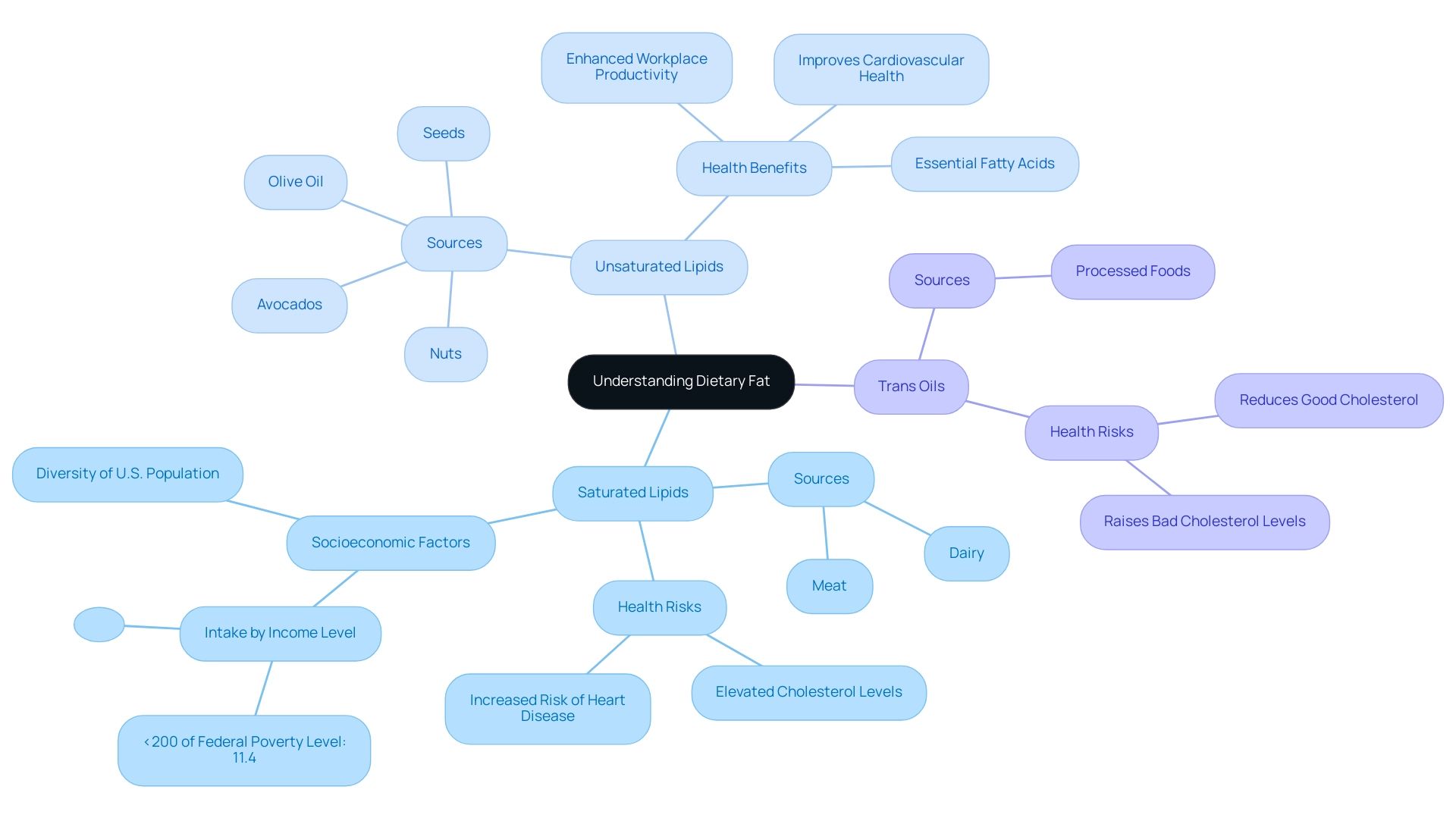
Practical Tips for Reducing Fat in Your Diet
Here are some compelling strategies to help you reduce fat in your diet effectively:
-
Choose Lean Proteins: Prioritize lean cuts of meat, poultry, and fish, and explore plant-based options like beans, lentils, and tofu. These sources are not only lower in fat but also packed with essential nutrients, supporting overall health. Recent statistics show that the share of consumers increasing their protein intake in the U.S. has risen significantly in 2023, reflecting a growing awareness of the benefits of lean protein.
-
Cook with Healthy Oils: Choose oils like olive or avocado instead of conventional substances such as butter or lard. These healthier oils not only enhance flavor but also contribute beneficial nutrients to your meals.
-
Read Food Labels: When grocery shopping, scrutinize nutrition labels. Aim for products that are low in saturated and trans oils, which can significantly affect your dietary lipid intake.
-
Limit Processed Foods: Processed foods are often laden with unhealthy fats. Instead, focus on whole, unprocessed foods like fresh fruits, vegetables, whole grains, and nuts that nourish your body without the excess fat. This aligns with the generational differences in cooking habits revealed in the 2021 case study on cooking frequency in the U.S., which shows younger generations are more inclined to cook at home.
-
Practice Portion Control: Be mindful of portion sizes, particularly with high-fat foods. To trim fat, reducing the amount you consume can greatly help in managing your overall fat intake.
-
Snack Wisely: Choose snacks that are low in fat, such as fresh fruits, vegetables, or whole-grain crackers, rather than chips or cookies. These healthier options can keep your energy levels stable throughout the day.
-
Experiment with Recipes: Seek out and experiment with recipes that minimize fat while maximizing flavor. Using herbs and spices to season dishes can enhance taste without the need for heavy, fatty sauces.
As Warren Teichner aptly noted, "Today, consumers are no longer simply trying out these wellness trends and hoping for the best, but rather asking, 'What does the science say?'" Integrating these practical tips into your daily routine, supported by scientific knowledge, can help you trim fat effectively, enhancing well-being and improving performance at work. Remember, incremental changes can lead to substantial improvements over time!
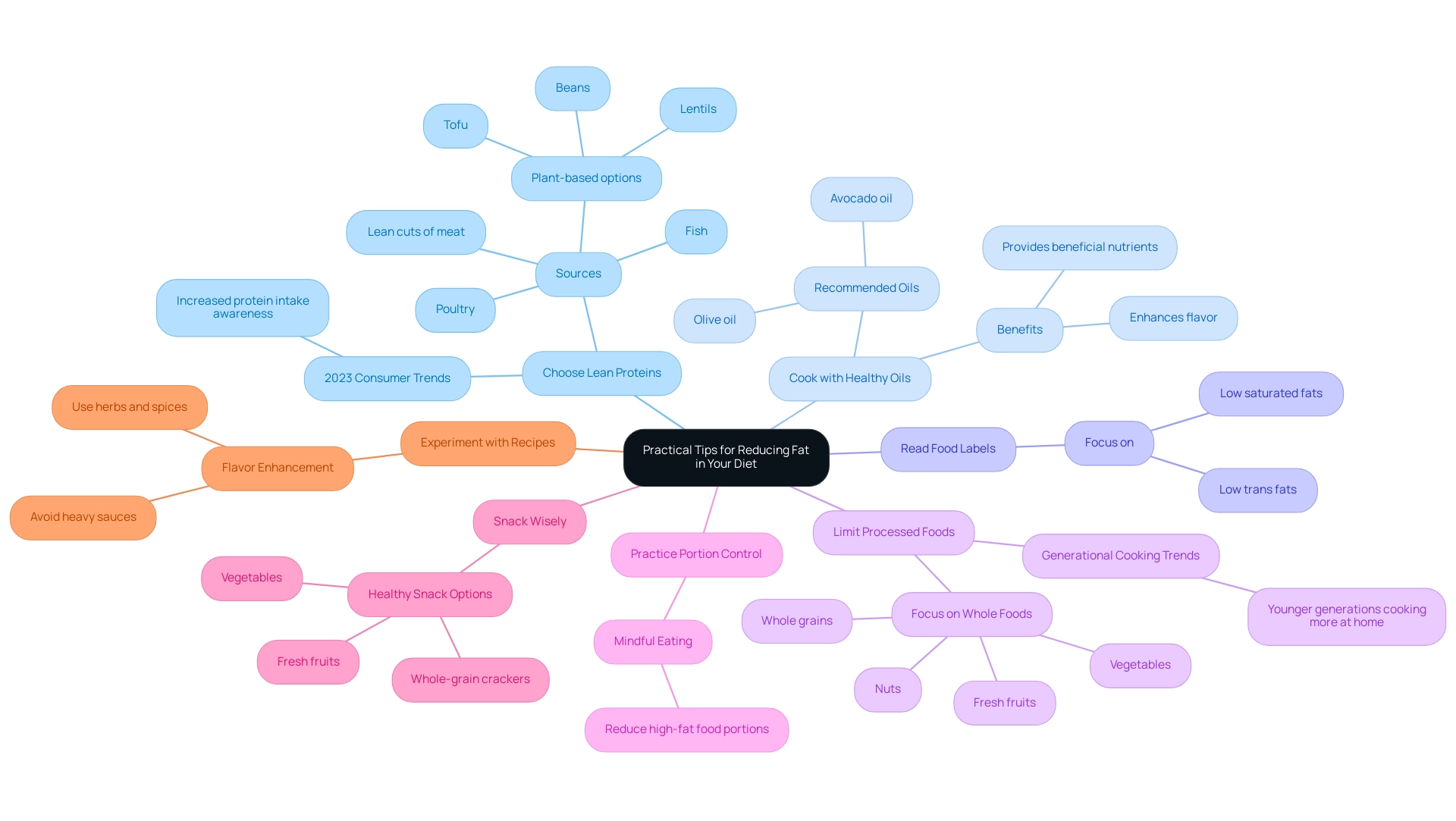
Meal Planning for a Low-Fat Diet
Creating dishes that trim fat can be an empowering journey towards better health, especially considering the concerning statistics in West Virginia, where only 8.4% of adults meet fruit intake recommendations and just 6.9% meet vegetable intake recommendations. Here are some effective strategies to guide you, bolstered by the personalized coaching approach that can help your team achieve lasting lifestyle changes:
- Set Weekly Goals: Begin by determining how many dishes you aim to prepare each week. With the guidance of experienced coaches, establish specific objectives to trim fat intake, focusing on gradual change rather than drastic shifts. One client shared, "With the help of my coach, I was able to set realistic goals that fit my lifestyle."
- Create a Balanced Menu: Make it a priority to include a colorful array of food groups, such as vibrant vegetables, whole grains, and lean proteins. This approach not only enhances nutritional value but also makes dishes visually appealing, contributing to a satisfying dining experience, which can be further supported by personalized coaching. As another client observed, "The assortment in my dishes has made healthy eating enjoyable."
- Prepare a Shopping List: Once your menu is set, draft a shopping list featuring low-fat ingredients. Adhering to this list can help you resist impulse buys that might derail your healthy eating intentions, especially with expert guidance on what to include. Coaches often recommend specific brands and products that align with your dietary goals.
- Batch Cooking: Consider preparing larger quantities of dishes in advance and portioning them for the week ahead. As Pauline Ducrot observes, although no causality can be inferred from the reported associations, this data implies that planning could potentially be relevant for obesity prevention. This method not only saves time but also ensures that you have healthy options readily available, making it easier to stick to your dietary goals and trim fat, particularly with the support of experienced coaches who utilize evidence-based techniques.
- Incorporate Leftovers: Get creative with leftovers to minimize waste and maximize flavor. For instance, leftover grilled chicken can easily be transformed into a delicious salad or wrap, providing a quick, nutritious lunch option, which can be further enhanced with personalized tips from your coaching team. Clients have discovered that reimagining leftovers has made food preparation more exciting.
- Use Healthy Cooking Methods: Opt for cooking techniques that promote health, such as grilling, steaming, or baking, while minimizing the use of oil. This not only helps to trim fat intake but also preserves the wholesome flavors of your ingredients, ensuring that you enjoy a varied diet. Coaches often share techniques that have been proven to maintain the nutritional value of dishes.
By embracing these dietary planning strategies alongside personalized coaching, you empower yourself and your team to take control of dietary choices. Not only does this facilitate the goal of trimming fat intake, but it also allows for the enjoyment of a diverse range of delicious foods. Furthermore, school-based initiatives have demonstrated that enhanced nutrition can significantly affect wellness outcomes, as healthy-weight children perform 13% better in school.
Effective meal planning is a key component in creating a healthier lifestyle, which companies can support through weight management programs for their employees. Contact us today to learn how our experienced coaches can guide your team towards healthier living!
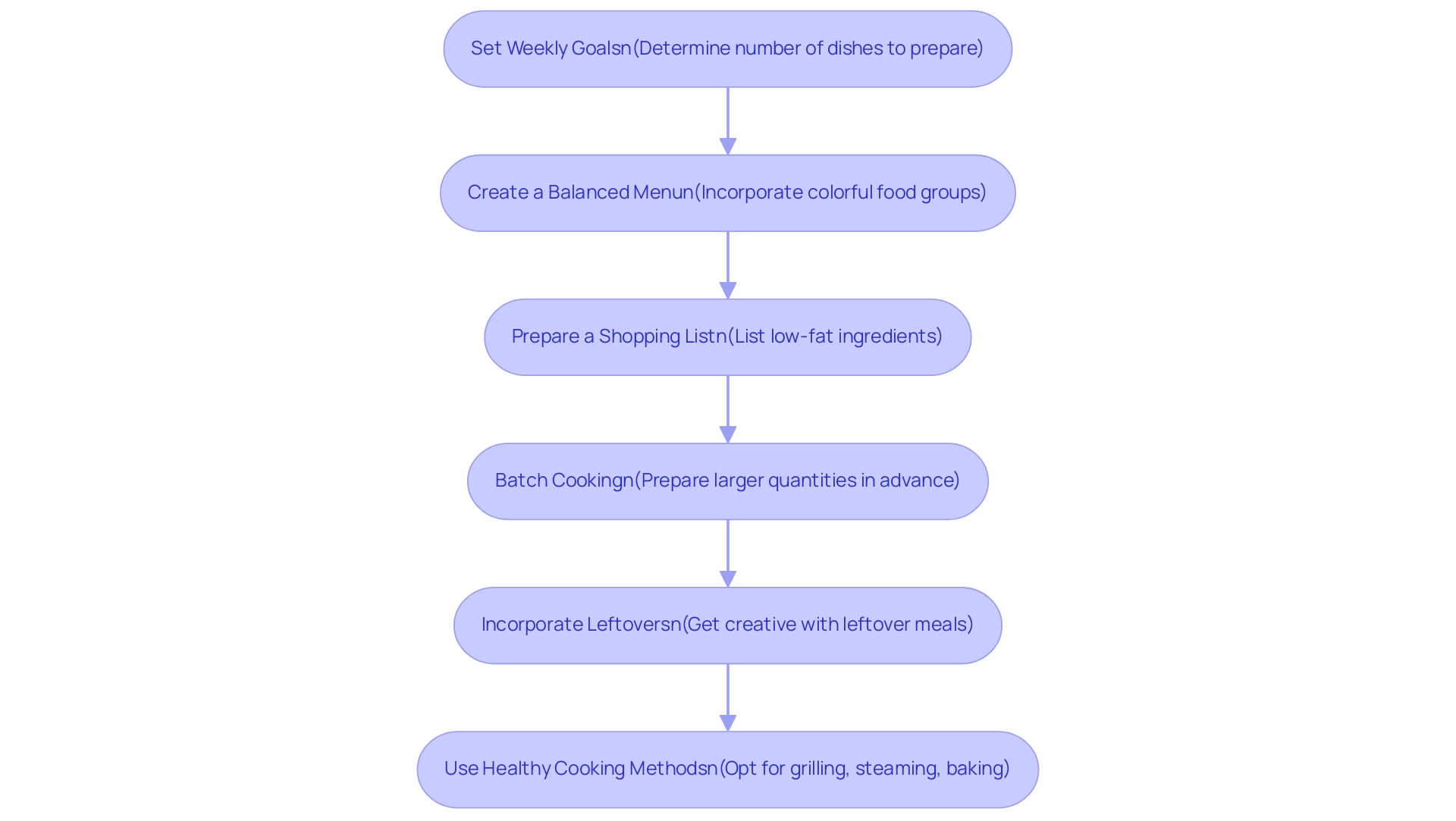
Incorporating Physical Activity into Your Routine
Incorporating regular physical activity can profoundly elevate your journey toward achieving a healthier diet. With California boasting the highest number of fitness clubs at 5,123, while Wyoming has only 81, accessibility to fitness resources varies significantly across the nation. Here are some effective strategies to ignite your commitment:
-
Choose Activities You Love: Engage in exercises that bring you joy, such as dancing, hiking, cycling, or yoga. Enjoyment increases adherence to your fitness routine, making it easier to commit long-term.
-
Establish Realistic Goals: Start with attainable objectives, like 30 minutes of physical activity three times a week.
As your stamina grows, gradually increase both the frequency and intensity of your workouts, ensuring a path to success.
-
Cultivate Consistency: Treat your workouts as essential appointments. Consistency is key to forming lasting habits that contribute to overall well-being, which in turn enhances your team's productivity.
-
Infuse Movement into Your Daily Routine: Opt for stairs instead of elevators, walk or bike to work, and take short breaks to stretch. These small changes accumulate to make a significant impact on your well-being and cognitive performance.
-
Team Up for Success: Find a workout partner to motivate each other and hold yourselves accountable. Group activities foster community and make exercising enjoyable, directly contributing to a healthier work environment.
-
Monitor Your Progress: Use a fitness app or journal to track activities and celebrate milestones, no matter how minor. This fosters a sense of achievement and encourages continued effort.
Moreover, research emphasizes that tailored corporate wellness initiatives significantly enhance employee engagement, productivity, and reduce burnout. A study published in the Journal of Occupational and Environmental Medicine found that workers who exercised moderately produced higher quality work and performed better than those who did not. Including enjoyable physical activity not only helps trim fat but also improves overall mental well-being, boosting confidence and alleviating stress for a satisfying life.
By effortlessly blending physical activity into your daily routine, you can trim fat while supporting your dietary objectives and enhancing your overall wellness and productivity. Our Customized App ensures that these wellness programs are easily accessible, providing personalized guidance from dedicated coaches tailored to your firm’s unique challenges. This holistic approach empowers your team to thrive in both personal well-being and professional responsibilities.
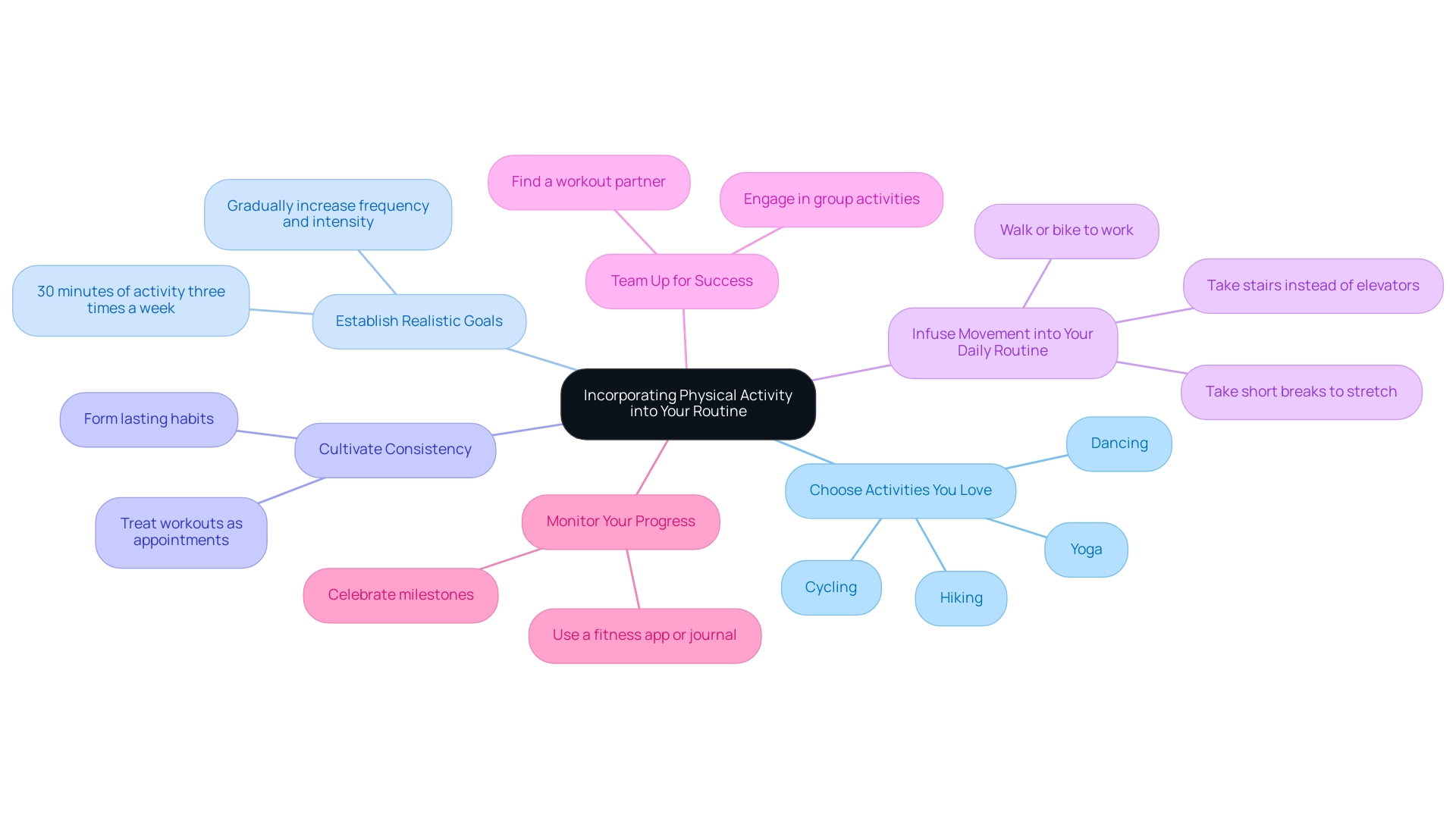
Staying Motivated on Your Low-Fat Journey
Sustaining motivation on your wellness journey can be challenging, but with the right strategies and support from Foresight Health Coaching, you can maintain the momentum. Research indicates that over 12 months, those who adopted a low-calorie eating plan (LCD) experienced an additional reduction in fat mass of 0.57 kg, highlighting how such changes can trim fat effectively. Here are some powerful techniques to elevate your commitment:
- Set Short-Term Goals: Transform your overarching wellness objectives into smaller, achievable milestones. Celebrating each milestone not only boosts your motivation but also reinforces your commitment to your goals. As Bethany Say, RD, LDN, CDCES, emphasizes, "Setting clear, attainable goals is crucial for long-term success in any nutritional plan."
- Keep a Journal: Tracking your food choices, emotions, and progress can provide significant insights into your journey. Regular reflection helps you recognize patterns and strengthens your resolve.
- Seek Support: Foresight Health Coaching offers tailored wellness programs, including fitness coaching and nutritional guidance, that foster a supportive community. Share your aspirations with friends, family, or support groups. A strong community fosters accountability and encouragement, making your journey less solitary and more enjoyable. The case study on societal changes for healthy eating illustrates how community support can enhance public welfare outcomes and promote healthier dietary choices.
- Reward Yourself: Treat yourself to non-food rewards as you hit specific targets, like new workout gear or a relaxing spa day. Positive reinforcement is integral to Foresight's philosophy, where personalized coaching sessions are designed to help you achieve your goals.
- Stay Flexible: Acknowledge that setbacks are a natural part of any journey. Instead of allowing them to derail your progress, view them as valuable learning experiences and adjust your plan accordingly.
- Visualize Success: Imagine yourself achieving your wellness goals; this powerful practice can significantly enhance your motivation and commitment to trim fat as part of a healthy lifestyle.
By actively implementing these strategies and taking advantage of Foresight's comprehensive health coaching services, including scalable corporate memberships that adapt to the number of employees, you empower yourself and your team to maintain motivation and focus on the journey to healthier eating. The app provided by Foresight plays a crucial role in supporting clients, facilitating tracking and community engagement, which not only promotes well-being but also boosts productivity, creating a positive ripple effect in your workplace.
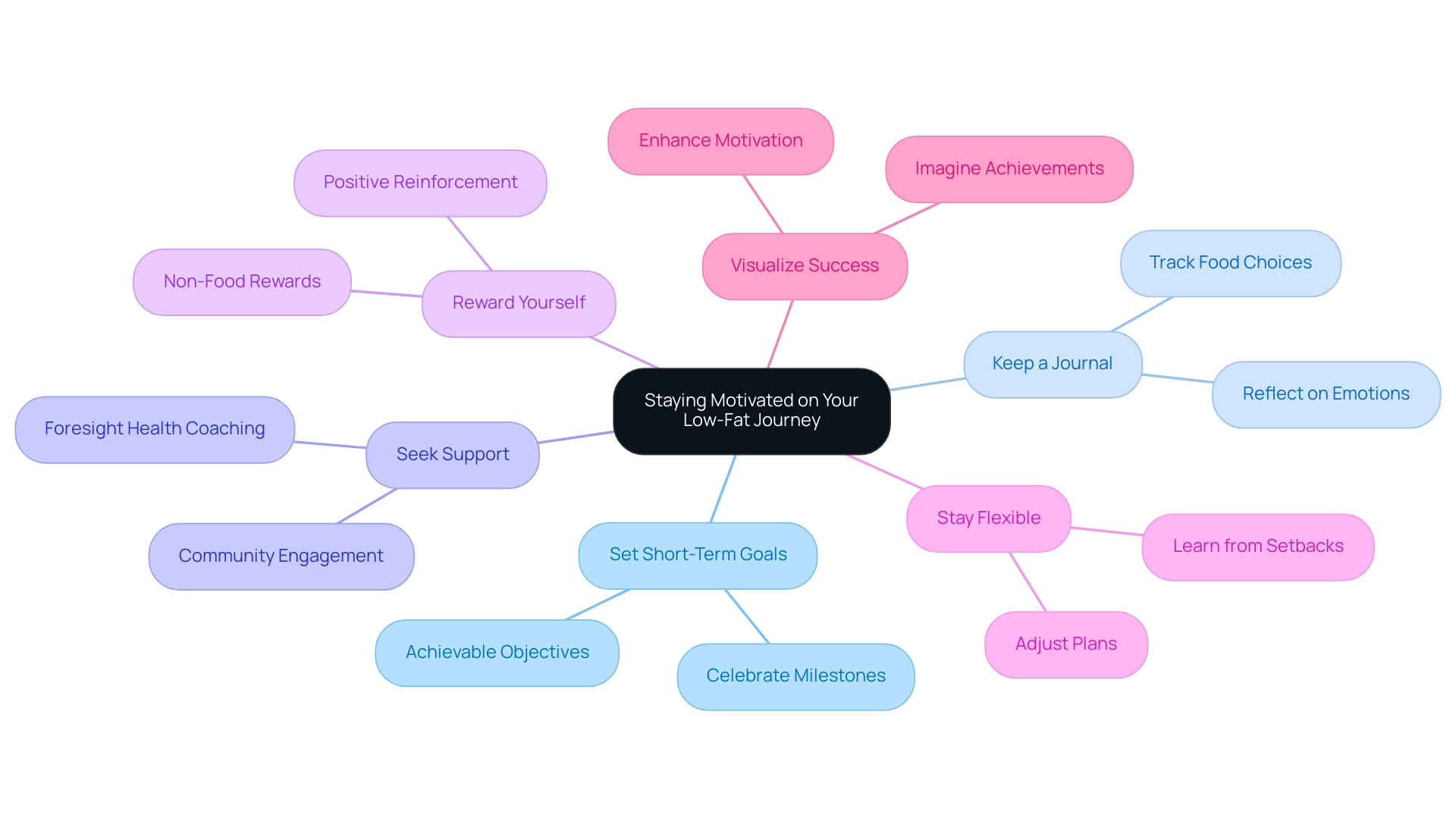
Conclusion
Embracing a deeper understanding of dietary fats is essential for fostering both personal health and workplace productivity. By categorizing fats into saturated, unsaturated, and trans fats, individuals can make informed dietary choices that significantly impact their overall well-being. Prioritizing unsaturated fats while minimizing saturated and avoiding trans fats can lead to improved health outcomes and enhanced morale within teams.
Implementing practical strategies to reduce fat intake—such as:
- Selecting lean proteins
- Cooking with healthy oils
- Planning balanced meals
empowers employees to take control of their dietary habits. Meal planning not only simplifies the process of maintaining a low-fat diet but also encourages creativity in the kitchen. Incorporating physical activity into daily routines further complements these dietary changes, reinforcing a holistic approach to health.
Staying motivated on this journey is crucial. Setting achievable goals, seeking community support, and celebrating milestones can sustain momentum and commitment. With the right tools and resources, such as personalized coaching and wellness programs, organizations can cultivate a culture of health that benefits both employees and the overall workplace environment.
In conclusion, prioritizing dietary awareness and physical activity is not just about personal health; it transforms workplace culture and enhances productivity. By taking proactive steps towards healthier eating habits and supporting one another in this journey, teams can create a thriving environment where everyone can flourish.




